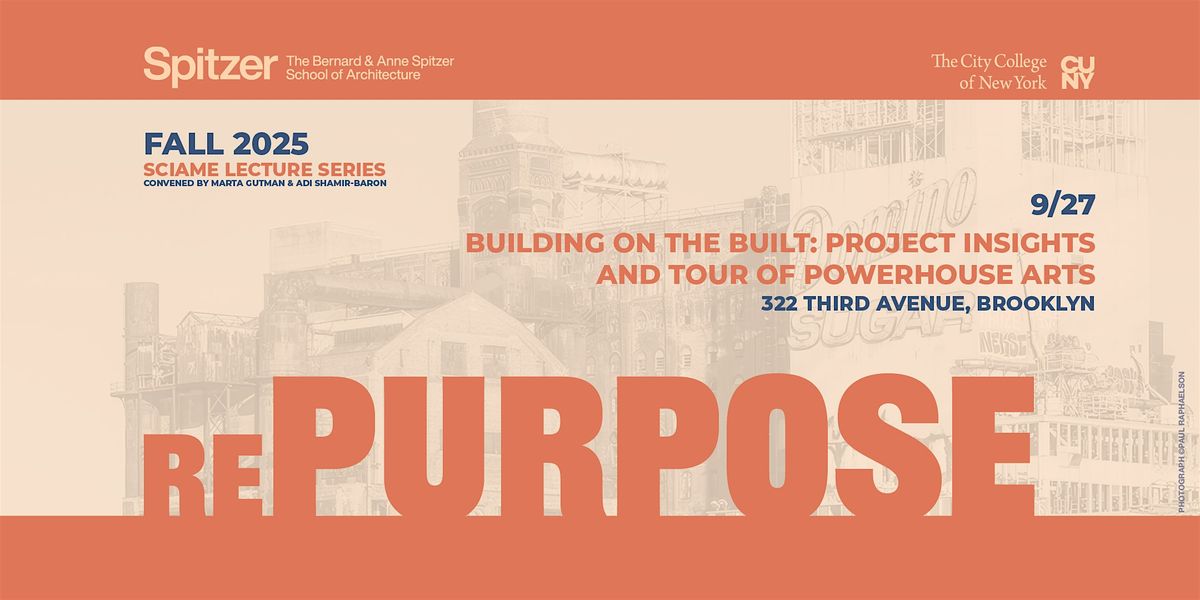
About this Event
This in-person lecture and tour is part of the Fall 2025 Sciame Lecture Series, "rePURPOSE." Please note this event will be held at
Powerhouse Arts322 3rd Ave, Brooklyn, NY 11215
Philip Schmerbeck (he/him) is the Studio Director overseeing the operations of Herzog & de Meuron’s studios in the USA. He began his collaboration with Herzog & de Meuron in Basel in 2007 and was the project director of 56 Leonard Street in Tribeca - his first project with the firm. After relocating to the New York office in 2008, he became project manager in charge of Parrish Art Museum through its completion in 2012; since this time he has maintained oversight of a diverse range of US projects including The Public Hotel, Leroy Street Residences and The Park Avenue Armory in New York City. He oversees the Powerhouse Arts project, a contemporary arts fabrication center recently completed in Brooklyn, the Memphis Art Museum, currently under construction on the banks of the Mississippi River, and the ongoing renovation of the landmarked Breuer Building for Sotheby’s Global Headquarters in New York. Through his diverse experience, he has gained specific knowledge working on a wide range of residential, cultural, and adaptive re-use projects.
"Building on the Built: Project Insights and Tour of Powerhouse Arts": Join us for an in-depth tour and talk on Powerhouse Arts, Herzog & de Meuron’s latest completed project in New York, and a striking example of the firm’s ongoing exploration of adaptive re-use—joining iconic works like Tate Modern (London), CaixaForum (Madrid), and Elbphilharmonie (Hamburg). Powerhouse Arts transformed a derelict, 115-year-old derelict power plant along Brooklyn’s Gowanus Canal into a 170,000-square-foot state-of-the-art manufacturing hub for artists and fabricators. Built atop a remediated Superfund site, the project preserves the site's industrial identity while anchoring a rapidly changing neighborhood with a bold civic presence. The tour will explore how the design retains and reinterprets the original Brooklyn Rapid Transit Power Station, stabilizing the historic Turbine Hall while reinterpreting its long-lost Boiler House. The completed ensemble harmoniously merges old and new—juxtaposing graffiti-covered brick and concrete vaults with new structural and high-performance systems infrastructure. Visitors will gain insight into the building’s vertical organization, which accommodates diverse stacked fabrication disciplines in metal, wood, textile, ceramic, and print-making while integrating best practices in industrial hygiene and long-term resilience. This tour reveals how adaptive re-use can extend the life of post-industrial structures, support creative economies, and bridge past and future through a sensitive, context-driven design process.
Suggested Reading: Mogilevich, M., Alvarez, L. G., & Hoplamazian, L. (2023, January 18). Cleaning Up? Remediation as Industrial Succession: Powerhouse Arts. Urban Omnibus.
"rePURPOSE" centers on the practice of adaptive reuse in the built environment. Repurposing, the practice of adaptive reuse, embedded in historical patterns of city building, and for the most part discarded in the modern movement, is undergoing a remarkable renaissance. In the Fall 2025 rePURPOSE lecture series, architects, planners, developers, advocates, and engineers will present the technologies, designs, economic incentives, and policy changes that are needed to advance a substantively renewed and at-scale program of repurposing in New York and other global cities. The reuse of old structures is not a new idea. (After the fall of the Roman empire, for example, the Colosseum was repurposed for housing and workshops during the medieval period). Although reuse is understood as a convention that both requires and imposes minimal impact, rePURPOSE shines light on how the methodology might not be entirely benign, how it might in fact have impact, and the ways in which it challenges and would necessarily disrupt the very conventions with which we typically assume it is aligned. Of special, although not exclusive, interest is unpacking the relationship of repurposing to the climate crisis. Might historic preservation sit at the center of technical innovation? Are all older buildings valuable as climate mitigation assets? What rules, laws, and incentives are needed to sustain innovative approaches to meaningful reuse?
Do preservation rules and laws need to be amended to allow for modification to protected historic fabric?Will financing tax credit incentive programs need to be created to enable ROI and economic impact?Measuring the environmental impact of reuse and whether it promotes or offsets economic development in emerging economies.Will new uses, such as data storage in old buildings, undermine the LCA embodied carbon savings achieved?To what extent will conversions such as office to residential require new zoning frameworks and complete reform of regulatory, density, and FAR considerations?Could conversions enable innovation in ventilation systems and even off-site transfer of geothermal energy systems energy and if maximized could represent significant impact?
All lectures are free and open to the public. For live captioning, ASL interpretation, or access requests, please contact .
This lecture series is made possible by the Spitzer Architecture Fund and the generous support of Frank Sciame ’74, CEO of Sciame Construction.
(Photograph ©Paul Raphaelson)
Event Venue & Nearby Stays
Powerhouse Arts, 322 3rd Avenue, Brooklyn, United States
USD 0.00










